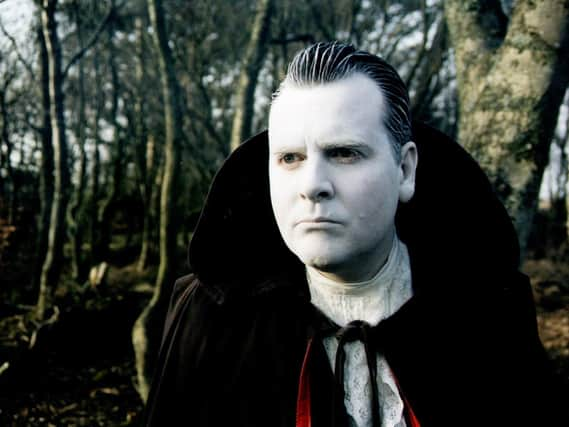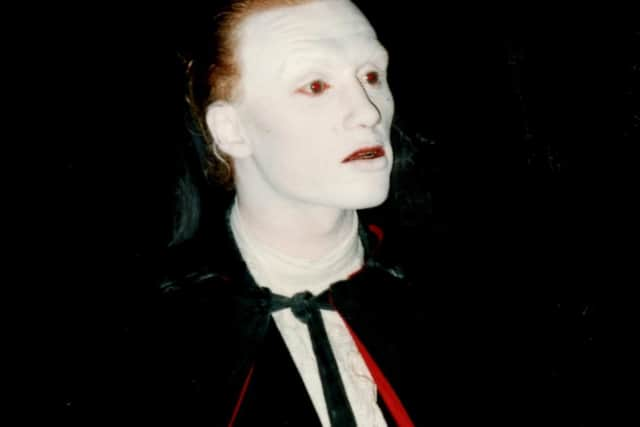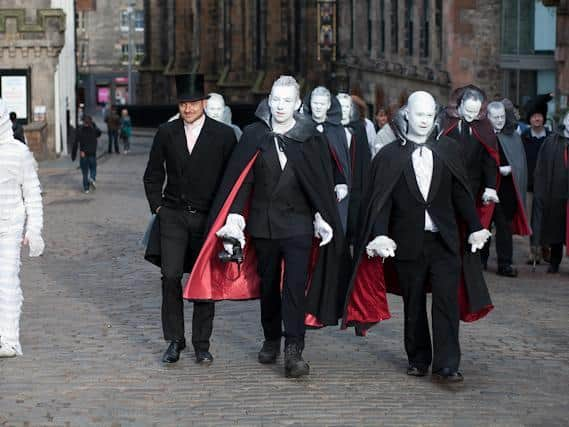Robin Mitchell of Edinburgh's original ghost tour reveals the similarities between dealing with the Capital's plague outbreaks of the 1600s and tackling the Covid-19 pandemic in the city


Look closely enough and you may even spot a small calling card case made from skin taken from the back of the left hand of serial killer William Burke, of Burke and Hare infamy.
A haven for all things Gothic then, the cluttered little shop wouldn’t look out of place on Harry Potter’s Diagon Alley.
Advertisement
Hide AdAdvertisement
Hide AdAt the back, a winding stone staircase leads to the shop’s vaults deep beneath the Capital’s streets and it is here, that owner Robin Mitchell waits to welcome visitors with a tale or two from the city’s gory past.


Cadies and Witchery Tours, Edinburgh’s original ghost walk, was co-founded by Mitchell and Iain Macphail in 1984 and it wasn’t long before Mitchell’s powdered white face and flowing black cloak became a familiar sight around the Old Town as he donned the guise of Adam Lyal (Deceased) to lead thrill-seekers through the closes and ‘cobbled’ streets of the Royal Mile and Grassmarket.
In the intervening years, Mitchell has appeared as Lyal on the back of Lothian Buses, on countless TV and radio shows, including Noel Edmond’s House Party, and has even stood for Parliament. Many Lyals have come and gone since and, although business might be slow right now, more than 35 years on, the Capital’s first ghost tour is marking a new milestone. Cadies have just employed their one hundredth jumper-ooter - an actor who stays one step ahead of the tour, jumping out, as the name implies, along the way to provide the scares and to occasionally throw a bucket of water over the unsuspecting participants.
Reflecting on the origins of the character, Mitchell, who still occasionally puts on the white face for a special occasion, reveals he was a real person. “We ‘found’ Adam Lyal in the Edinburgh Room of the Central Library. We liked the name, so brought him back to life,” he recalls.
Advertisement
Hide AdAdvertisement
Hide AdThe story of Adam Lyal is an intriguing one. In October 1810, highwayman Adam with his brother John robbed a cattle dealer near Stirling of £126, a fortune in those days, and came to Edinburgh to spend some of their ill-gotten gains. Mitchell takes up the tale, “With his earnings, Adam bought a new pair of boots for £2 8/- from a W Brown Bootmaker of 17 Leith Street and a pair of spurs from a saddler on the east side of South St Andrews Street for 12/-.


“They then booked into Shaw’s Hotel at 21 Princes Street. Not the most intelligent thing to do as they stood out like sore thumbs. The authorities were called and they were arrested. John avoided execution by pleading insanity and was shipped to Botany Bay. Adam was convicted and executed on 27 March 1811 with the Edinburgh Evening Courant newspaper reporting the following day: ‘On Wednesday, Adam Lyall was executed here pursuant to his sentence for the robbery of Mathew Boyd, cattle-dealer. He was assisted in his devotions by the reverent Mr Andrew Thomson, minister of the New Grayfriars, and the reverend Mr Porteous, chaplain of the jail. He behaved with great penitence and resignation’.”
In 2011, Cadies Tours celebrated 200 years of Lyal’s execution with all the ‘old’ Lyals gathering for a day of remembrance. “Well, we all got into costume, shared some anecdotes and ate some cake,” laughs Mitchell, who conducted the first ever Witchery Murder and Mystery Tour as Lyal on 26 October 1985.
Some 52 others have also played the role in the intervening years. The most famous of those was Hollywood actor Kevin McKidd of Trainspotting and Greys Anatomy fame, who donned the black cloak in the early-1990s while studying at Queen Margaret University.
Advertisement
Hide AdAdvertisement
Hide AdHaving hosted tours for the likes of the late Joan Rivers, Star Trek’s Mr Sulu, actor George Takei, and the rock band Iron Maiden in the past, the current downturn in demand for tours, thanks to the Covid-19 outbreak, piqued Mitchell’s interest to discover how the Capital has dealt with similar situations in the past.
Part of the tour covers the many plagues that have afflicted the city over the centuries and, at a time when it is no longer unusual to see people wearing masks as they go about their daily business, he reveals actions taken during outbreaks of illness in the past, often reflect those being taken today.
Poignantly the use of masks brings to mind the Foule Clengers, he says, men who were responsible for the collection of bodies from plague-infected houses in the city in the 1600s. Wearing a grey gown with white St Andrews crosses on the front and back to provide spiritual protection against the plague, they also wore a strange beak-like hood made from leather. The ‘beak’ was filled with herbs and flowers to keep away the plague.
Mitchell reveals, “Persons living in households infected were not permitted to go outside, under pain of death. The plague’s victims were carried off in horse-drawn carts and buried in mass graves, better known today as The Boroughmuir, Leith Links, and behind Holyrood Palace.”
Advertisement
Hide AdAdvertisement
Hide AdIt’s sobering to think that, while numbers aren’t available for Edinburgh, during the last and worst plague of 1645, Leith had a population of about 5,000 and exactly 2,421 perished.
Mitchell reflects, “One of the perks of being a Clenger was that you got to keep the clothes and possessions of the plague victims, though they had to be boiled first. One of the drawbacks was that the constant exposure to infection often led to death within four months, meaning they never lived long enough to collect their £100 salary.”
If the Clengers’ distinctive masks were 375 years ahead of the times, another action which chimes with us today is a ban on social gatherings. “On 31 March 1645, gatherings after weddings and funerals were banned,” reports Mitchell, “and the Council moved from Edinburgh to Stirling when the plague arrived in the Capital. The equivalent today of social distancing and working from home.”
He adds, “And if more draconian measures are introduced in 2020, it might mirror what happened in the plague of 1530. St Andrews had the plague before Edinburgh and when a certain Margaret Cook from St Andrews entered Edinburgh, she was arrested for concealing the disease. For this crime she was branded on both cheeks, her clothes were burnt, and she was banished from Edinburgh for ‘all ye dayis of hir lyf’.”
Advertisement
Hide AdAdvertisement
Hide AdFood supplies too were an issue in the seventeenth century. “In August 1646 the citizens of the Capital were faced with food shortages, not self-inflicted panic buying though, but genuine food shortages,” says Mitchell.
So it seems Edinburgh has indeed been here before, and as the streets empty and people attempt to flatten the curve, Mitchell agrees, “There have been a number of epidemics of plague here over the years. The restrictions make interesting reading today, and include a 10pm curfew where all taverns and schools should be closed and banning people from exiting the city for 40 days.”
Visit www.witcherytours.com for more details